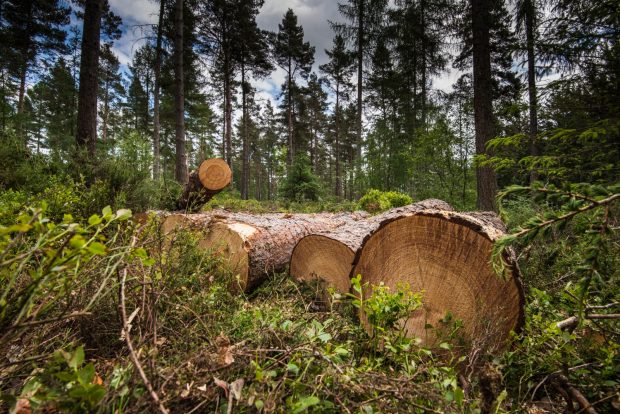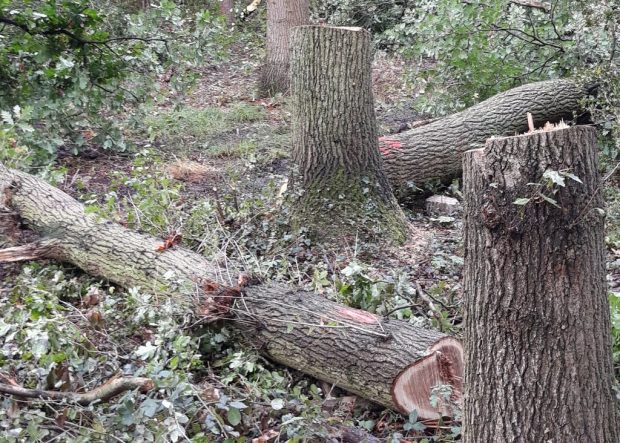
For many of us, the opportunity to exercise locally and enjoy the natural environment around us is very important to our wellbeing. This might be visiting a nearby park, nature reserve or woodland, or using a local cycle trail. Whichever it is, I’m sure you would agree the importance of protecting it for everyone to enjoy.
Taking a step back from our usually busy lives, I’ve certainly found that whilst enjoying local green spaces on a regular basis you tend to notice what’s in the landscape more than perhaps you might have done before.
So, why is our local environment this important that it needs protecting? Trees, woodlands and forests are sensitive spaces. They provide shelter and food for wildlife and are important habitats for our own recreation. The spaces they take up form part of the wider landscape we see around us; one we have treasured for millennia. We now understand just how much they can reduce the impact of climate change by absorbing carbon dioxide as they grow, improve water quality, alleviate flooding and reduce soil erosion.
Trees and woodlands also provide us with valuable timber resources which are needed to make a wide range of daily products, and as biomass for fuel and energy production. The felling of trees is therefore a normal and important part of good woodland management. It is also key to sustaining good woodland condition by letting in light that allows natural regeneration to happen and wildlife to thrive.
Therefore, our local trees and woodlands need to be managed in the right way and at the right time of year, and most importantly, that the felling is managed legally. It goes back to my point above about protecting the environment and being aware of any changes taking place which may or may not have a detrimental effect on the landscape.
Before anyone can cut down trees, they may need to get a felling licence from the Forestry Commission.
It is an offence to fell trees without a licence, where one would have been required. There are some exceptions that can apply, but in many instances a felling licence will be required. These licencing measures are not new; they have been in force for 50 years. They help maintain compliance with environmental standards that ensure the sustainability of woodland management and wood production (UKFS) to protect England’s highly valued trees and woodlands. You can read more about this in our guide ‘Tree Felling – getting permission’ which explains when a felling licence is needed and how to apply for one.
As the Government’s forestry experts, we are continuing to carry out our functions as the forestry industry regulator, as plant health inspector and as government advisor during these challenging times. These duties include continuing to process what will be several thousand felling licence applications this year, applied for via the Felling Licence Online system, and, as you might expect, investigating instances of alleged illegal felling.

As I mentioned before, there are some circumstances where a felling licence isn’t needed and therefore felling trees isn’t illegal. Some examples of this are:
- felling trees in gardens, churchyards or a public open space
- felling trees with a diameter less than 8cm (the width of baked bean can) at a height of 1.3m on the main stem
- felling trees to prevent the spread of a quarantine pest or disease, as required under a Statutory Plant Health Notice
- up to 5 cubic metres of timber (a stack of timber the size of a small car) may be felled each calendar quarter without a felling licence.
If you are concerned about local tree felling, and, having ruled out these scenarios above you still suspect anyone of cutting down trees without permission, then you should follow our advice online about reporting the suspected illegal felling incident to us.
To help us to manage and respond to reports of alleged illegal felling, there are some checks that you should do before you do report an incident to us. These include checking if a felling licence is already in place for the work, or if the work is part of infrastructure management e.g. by highways authorities, energy network companies or railway authorities.
If these checks don’t satisfy your concerns, you should report this incident to us at the Forestry Commission. We will need some details from you about the tree felling in order to investigate, such as the exact location, when the felling started, and who is doing it. This information will allow us to investigate the report and assess whether a felling licence was required or not, and where one was, to take the necessary enforcement action.
It is heartening that the public often act as our eyes and ears by proactively reporting instances of alleged illegal felling when something doesn’t seem quite ‘right’; helping to protect our trees, woodlands and forests from long term and even irreversible damage. So for that, thank you.
As the regulator we will, as always, continue to investigate the reports that we receive whilst following current advice on social distancing, assess and monitor compliance of approved felling licences, and pursue enforcement action on individuals and organisations who fail to comply with the rules, protecting our trees and woodlands for future generations to enjoy.
Advice on how to report instances of suspected illegal tree felling can be found at https://www.gov.uk/guidance/report-suspected-illegal-tree-felling



7 comments
Comment by Mark Antcliff posted on
Good to promote this but I think you should add a reference to trees protected by the town and country planning acts - Conservation areas, tree preservation orders and planning conditions.
Comment by Faye Dawson posted on
Of course, you are right about trees with these protections, and where a felling licence is required, one should be obtained. However, many protected trees are in locations outside of the control of the felling licence regime, or the work to be undertaken is not that of tree felling itself. In these instances, it is the local planning authority, not the Forestry Commission, who have responsibility for regulation and enforcement.
Comment by D.Long posted on
SHEFFIELD TREE FELLING INVESTIGATION REPORT
FORESTRY COMMISSION – 18th July 2019
SELECTED EXTRACTS
PAGE 2:
“SCC HAVE CONSISTENTLY CLAIMED THAT ALL FELLING CONDUCTED UNDER THE STREETS AHEAD PROGRAMME IS IN RESPONSE TO ITS STATUTORY DUTY UNDER THE HIGHWAYS ACT 1980 (the Highways Act) - to maintain the public highway, and the Equality Act 2010 (the Equality Act) - to make reasonable adjustments to accommodate the needs of disabled people.”
PAGE 3
“INTRODUCTION
This report considers the felling of predominantly street trees carried out by Sheffield City Council (SCC) and their contractors (Amey) during the period of July 2012 to April 2018 in the context of the need for a felling licence contained within the FORESTRY ACT 1967 (the Act).”
PAGE 5:
“SECTION 9(4)(b) OF THE ACT PROVIDES AN EXCEPTION TO THE NEED FOR A LICENCE where a person, or organisation, is placed under a duty by another Act of Parliament (or Statutory Instrument, such as Regulations, Orders etc., made under an Act). Attention should be drawn to the word “obligation” above. It is considered that “obligation” is synonymous with the word “duty”.
A STATUTORY “POWER” TO DO SOMETHING IS INSUFFICIENT TO ENGAGE SECTION 9(4)(B). THERE MUST BE AN IMPERATIVE TO DO SOMETHING, NOT JUST THE OPTION TO DO IT.”
PAGE 23:
“Despite the above, SCC CONSISTENTLY CHOSE TO MEET THEIR DUTIES UNDER THE HIGHWAYS ACT BY FELLING TREES, RATHER THAN BY MAINTAINING THEM IN SITU. Often this has been in the face of local objections, hence the formation of the STAG. Had some of the above methods been adopted instead, the FC would likely not have been obliged to assess the maintenance programme for alleged illegal felling.”
Page 15:
“INTERPRETATION
As set out above, potentially ~600 TREES WERE FELLED BY SCC AND AMEY WHICH MAY HAVE REQUIRED A FELLING LICENCE. As no felling licence was in place, AN OFFENCE UNDER SECTION 17 OF THE ACT MAY HAVE BEEN COMMITTED.
SOURCE:
https://www.gov.uk/government/publications/alleged-illegal-tree-felling-investigation-report-sheffields-streets-ahead-programme
http://web.archive.org/web/20190724045225/https://www.gov.uk/government/publications/alleged-illegal-tree-felling-investigation-report-sheffields-streets-ahead-programme
For further detail, see:
‘BIGGEST EVER SCHEME TO IMPROVE SHEFFIELD’S 36,000 STREET TREES’:
https://web.archive.org/web/20171205143508/https://www.thestar.co.uk/news/biggest-ever-scheme-to-improve-sheffield-s-36-000-street-trees-1-5412367
'IMPORTANT NEWS ARCHIVE':
https://ianswalkonthewildside.wordpress.com/2016/08/12/sheffield-tree-campaign-back-in-the-national-news-in-the-guardian/#comment-2695
‘STREET TREES: MYTH VS FACT’:
(a letter that Mr Long sent to The Star & The Yorkshire Post, dated 22nd December 2017. Not printed. Includes audio evidence):
https://ianswalkonthewildside.wordpress.com/2017/12/21/merry-christmas-to-all-our-tree-fellas/#comment-1991
‘MISINFORMATION & MISREPRESENTATION’
(a letter that Mr Long sent to The Star, dated 14th September 2017):
https://ianswalkonthewildside.wordpress.com/2017/09/10/ignorance-pig-headedness-and-bullying-remain-the-order-of-the-day-for-the-sheffield-street-trees-strategy/comment-page-1/#comment-1802
PRESENTATIONS FROM THE SECOND (FINAL) MEETING OF THE 'BI-MONTHLY' SCC / AMEY HIGHWAY TREES ADVISORY FORUM':
https://ianswalkonthewildside.wordpress.com/2020/05/01/mystery-photograph-of-the-day-no-26/comment-page-1/#comment-4368
'THE STREET TREE FELLING QUOTA & PENALTIES':
https://ianswalkonthewildside.wordpress.com/2019/12/07/a-wild-christmas-cheer/comment-page-1/#comment-3949
NOTE:
If the above links don't work, to use one, highlight it, right click and select 'open link'. Alternatively, to use a link, copy & paste it in to your address bar.
Comment by Chris Stapleton posted on
A golf course in Widnes Cheshire has just had plans drawn up for a development of over 255 houses. It has 100s if not a 1000 of trees on it.
Can we pre notify you if planning permission is granted by Halton Borough council.
Comment by Faye Dawson posted on
The Forestry Commission is a non-statutory consultee on planning applications impacting ancient woodland. Along with Natural England we provide standing advice on the protection of ancient woodland, ancient trees and veteran trees from development. It is for the planning authority to take on board this and other environmental advice when determining the planning application.
Comment by D.Long posted on
It is important to remember that the UK Forestry Standard does not just apply to 'woodlands'; it applies to all forests and forest lands. To quote:
"The UKFS and guidelines encompass the entire forest
environment...
They apply to the planning and management of forests within the wider
landscape and land-use context, and to all uk forest types and management systems, including the collective tree and woodland cover in urban areas."
That includes urban forests and their tree populations - including highway trees. The licencing system does not just apply to rural or urban woodlands. For example, it applies to local authority contracts that propose to fell thousands of mature street trees for convenience rather than necessity. The Forestry Commission have recently published new guidance to help those responsible for highway trees avoid criminal wrongdoing. For detail, see:
Highway tree management: operations note 51:
https://www.gov.uk/government/publications/alleged-illegal-tree-felling-investigation-report-sheffields-streets-ahead-programme
http://web.archive.org/web/20190724045225/https://www.gov.uk/government/publications/alleged-illegal-tree-felling-investigation-report-sheffields-streets-ahead-programme
Comment by Robert McBride posted on
With this knowledge it is just quite incredible that the destruction, wanton destruction of 6,000 Street trees in Sheffield was allowed to take place. The so called, professional tree sectors darkest hour. Why it was left to campaigners at SORT to highlight and fight against this to begin with is beyond me.
Someone in the then cabinet of Sheffield city council deserves to go to jail over their illegal actions and environmental vandalism.